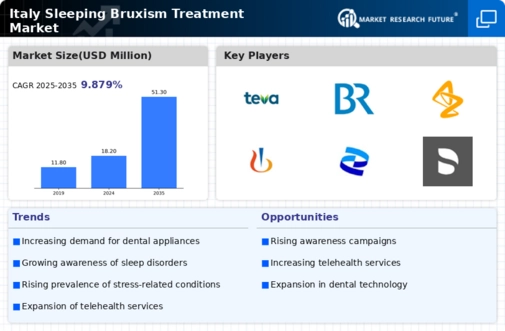Rising Stress Levels
The correlation between stress and bruxism is well-documented, and the increasing stress levels in Italy appear to be a significant driver for the sleeping bruxism-treatment market. Factors such as economic pressures, work-related stress, and lifestyle changes contribute to heightened anxiety, which can exacerbate bruxism symptoms. According to recent studies, approximately 30% of the Italian workforce reports high levels of stress, which may lead to a rise in bruxism cases. Consequently, this trend is likely to boost the demand for treatment options, as individuals seek relief from both stress and its physical manifestations, thereby propelling the sleeping bruxism-treatment market forward.
Growth of Dental Care Services
The expansion of dental care services in Italy is another vital driver for the sleeping bruxism-treatment market. With an increasing number of dental clinics and specialists focusing on oral health, patients have greater access to bruxism treatments. The Italian dental market has seen a growth rate of approximately 5% annually, indicating a robust healthcare infrastructure. This growth facilitates the introduction of innovative treatment options, such as custom-made mouthguards and advanced therapeutic techniques. As dental professionals become more equipped to diagnose and treat bruxism, the sleeping bruxism-treatment market is expected to flourish, catering to a broader patient base.
Increasing Awareness of Bruxism
The rising awareness of bruxism among the Italian population is a crucial driver for the sleeping bruxism-treatment market. As more individuals recognize the symptoms and potential consequences of this condition, there is a growing demand for effective treatment options. Educational campaigns by dental associations and healthcare providers have contributed to this awareness, leading to an increase in consultations and diagnoses. In Italy, it is estimated that around 10% of adults experience bruxism, which translates to a significant market opportunity. This heightened awareness is likely to drive the adoption of various treatment modalities, including dental splints and behavioral therapies, thereby expanding the sleeping bruxism-treatment market.
Technological Innovations in Treatment
Technological advancements in treatment options are significantly influencing the sleeping bruxism-treatment market. Innovations such as 3D printing for custom dental devices and the development of biofeedback mechanisms are enhancing the effectiveness of treatments. In Italy, the integration of these technologies into dental practices is becoming more prevalent, allowing for personalized treatment plans that cater to individual patient needs. This trend not only improves patient outcomes but also encourages more individuals to seek treatment for bruxism. As technology continues to evolve, the sleeping bruxism-treatment market is likely to experience substantial growth, driven by the demand for more effective and tailored solutions.
Increased Focus on Preventive Healthcare
The growing emphasis on preventive healthcare in Italy is a notable driver for the sleeping bruxism-treatment market. As healthcare systems shift towards preventive measures, there is a heightened focus on early diagnosis and intervention for conditions like bruxism. This trend is supported by public health initiatives aimed at educating the population about the importance of oral health. With an increasing number of individuals seeking preventive care, the demand for bruxism treatments is expected to rise. This proactive approach not only benefits patients but also contributes to the overall growth of the sleeping bruxism-treatment market, as more people become aware of the need for timely intervention.

















Leave a Comment